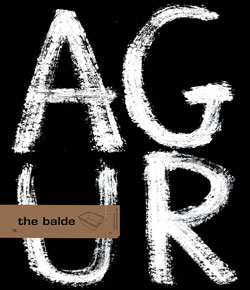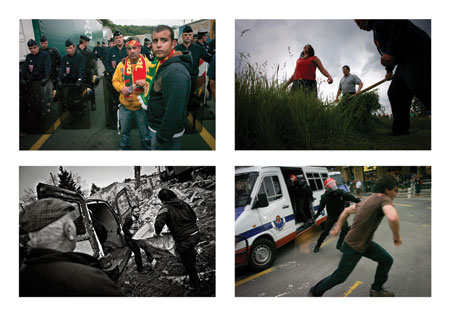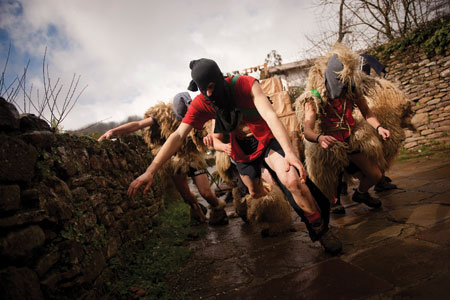about photo journalism with gari garaialde
“Goya’s 18th century war drawings are the foundations of photo journalism. They aren’t photos, but the artist from Aragon drew war and massacres from a particular angle which makes those who see his work witnesses to those brutal events. And that is exactly what photo journalism has to do. Photo journalism simplifies and brings to the surface what we would not otherwise see. But sometimes we don’t see because we don’t even look”.
thorne anderson
fotokazetaria / photo journalist Maybe it’s only my imagination, but I think that most people only understand one part of the term “photo journalism”, and it’s “photo”. But it is not widely accepted that a photo by itself, with no other word describing it, can be journalism. Am I wrong in my diagnosis about this lack of recognition?
Well, I don’t think that a photo, without any other word to describe it, can be journalism. A photo by itself cannot give information if there are no words accompanying it to give it a context. But I am quite sure that, as well as going with and supporting a headline, photos can be used in a very wide variety of ways for giving information.
Perhaps what newspapers and magazines do with your work (trimming photos for editing purposes, turning them around, etc.) doesn’t help either.
No, it doesn’t help, but even worse than that is forgetting the information that photos can give, and that type of bad handling is just a consequence of forgetting that.
You’ve been working to make photo journalism better known and more visible for a long time now. You´ve shown different photographers’ work and give ideas and tricks about how to carry out this type of work. What is photo journalism’s situation in the 21st century press?
The printed press is in a very difficult situation. Paper is very expensive at the moment, and in-depth illustrated features take up a lot of space and, as well as that, this crisis, which which has left journalism in a state of confusion about what it should be doing, has affected photo journalism too. On the other hand, there are no problems about space on the net, there are lots of different ways to publish work there and you can see a lot of excellent features there. New ways of doing things have also been invented: movement, photos, voices, the possibility of combining texts and other elements... But finance is the problem because internet magazines are not yet profitable. houses all fit in. To an extent, I find it easier to talk about events and, around them, there are hundreds more stories to be told. Digital technology has created problems of veracity for photography.
Lots and lots of collages and retouched photos have been published by people like National Geographic and New York Times and then they’ve had to apologise for them. How much can a photo be retouched before its loses its veracity?
Photography’s always had a problem with veracity and, what’s more, from the very start it wanted to tell stories rather than reflect the truth. The techniques did not allow photographers to show things as they were, they had to use collages, stage things. I don’t think it’s photography that creates a lack of confidence: when that happens, it’s because of journalists
or photographers. If journalism is credible, its results will always be credible, whatever the words or the photos tell us about. At most, digitalisation has made one type of trick easy to do: it isn’t easy to draw the line between taking photos and what we do with them later on, but I think there is a step between the photos we take and those photos
And is that the situation in the Basque Country, or are there any differences?
We live in two states, and they have their own, different traditions, laws and ways of doing things. But, in general, apart from the differences because the Basque Country is small, I think we’re in the same situation as they are in other places. Photographers are often in uncomfortable places, in many different circumstances.
Many photo journalists say that they must always follow the criteria of neutrality and objectivity. Others say that they have the right to take part in favour of justice and the oppressed. What do you think about this?
I think that journalists in general, and photo journalists too, must throw off the weight of objectivity and impartiality. Objectivity is impossible, whatever you are reporting on, because there are always some areas or points of view that you do not give as much coverage to as you should do, and even somebody who thinks he or she has been completely impartial will find people who accuse him or her of bias. Journalists must be independent, free to skilfully report without any pressure or interference and, after that, they will be able to report on oppressed people’s concerns or tell us about the victors: that’s each person’s right. The key is that what they tell us must be true.
You tend to always associate photo journalism with wars and big events. Important names come to mind: Capa, Salgado, Natchwey, Sanchez… But there is also photo journalism on a smaller scale which gets involved with daily life, things which are
closer to home …
At the end of the day, photo journalism is using photos to tell stories. So stories about people who live in this world, about things which matter to us, so the war in Libya, the political situation in Nagorno-Karabakh and, in our country, people being evicted from their reflecting reality. When you want to reflect something which isn’t there, you over dramatise it, taking something from it or adding something to it ... I’d say people know when they’ve gone over that line.
In connection with that, and as we are now fully in a digital age, almost anyone can have an HD camera nowadays and the media increasingly use photos sent in by the public. What is a professional photographer’s life like?
I’m not particularly worried about the number of cameras around and, to an extent, the media’s use of those photos is perfectly normal. It’s an impossible dream to hope that there will always be a professional photographer around whenever anything happens, but a passer-by may be able to take a photo using a mobile phone. We professional photographers should know how to cover events and tell stories. We should be able to go beyond simple events with our journalistic awareness. But the media are full of events because they, too, gave up journalism a long time ago: and that’s where we can’t compete, with those private individuals, amongst other things because people love having their photos published and don’t charge anything for them. But then the reliability of the source comes into question, to what extent a particular medium knows the person who has offered them that photo ... It’s similar to the problem with written journalism and bogs, but newspapers don’t accept what anybody’s written as being the truth ... or sometimes they do.
To end, tell us what you carry in your pockets when you’re working.
That depends on the type of work. For football and some other specific types of work, we have to take a long-distance lens but, normally, a mobile phone, keys, money, the newspapers and, in my hand, a camera with 24-70 mm zoom. I’m happiest working with 28 or 25 mm lenses because that makes me get up close to the situation I want to report.
thorne anderson
fotokazetaria / photo journalist Maybe it’s only my imagination, but I think that most people only understand one part of the term “photo journalism”, and it’s “photo”. But it is not widely accepted that a photo by itself, with no other word describing it, can be journalism. Am I wrong in my diagnosis about this lack of recognition?
Well, I don’t think that a photo, without any other word to describe it, can be journalism. A photo by itself cannot give information if there are no words accompanying it to give it a context. But I am quite sure that, as well as going with and supporting a headline, photos can be used in a very wide variety of ways for giving information.
Perhaps what newspapers and magazines do with your work (trimming photos for editing purposes, turning them around, etc.) doesn’t help either.
No, it doesn’t help, but even worse than that is forgetting the information that photos can give, and that type of bad handling is just a consequence of forgetting that.
You’ve been working to make photo journalism better known and more visible for a long time now. You´ve shown different photographers’ work and give ideas and tricks about how to carry out this type of work. What is photo journalism’s situation in the 21st century press?
The printed press is in a very difficult situation. Paper is very expensive at the moment, and in-depth illustrated features take up a lot of space and, as well as that, this crisis, which which has left journalism in a state of confusion about what it should be doing, has affected photo journalism too. On the other hand, there are no problems about space on the net, there are lots of different ways to publish work there and you can see a lot of excellent features there. New ways of doing things have also been invented: movement, photos, voices, the possibility of combining texts and other elements... But finance is the problem because internet magazines are not yet profitable. houses all fit in. To an extent, I find it easier to talk about events and, around them, there are hundreds more stories to be told. Digital technology has created problems of veracity for photography.
Lots and lots of collages and retouched photos have been published by people like National Geographic and New York Times and then they’ve had to apologise for them. How much can a photo be retouched before its loses its veracity?
Photography’s always had a problem with veracity and, what’s more, from the very start it wanted to tell stories rather than reflect the truth. The techniques did not allow photographers to show things as they were, they had to use collages, stage things. I don’t think it’s photography that creates a lack of confidence: when that happens, it’s because of journalists
or photographers. If journalism is credible, its results will always be credible, whatever the words or the photos tell us about. At most, digitalisation has made one type of trick easy to do: it isn’t easy to draw the line between taking photos and what we do with them later on, but I think there is a step between the photos we take and those photos
And is that the situation in the Basque Country, or are there any differences?
We live in two states, and they have their own, different traditions, laws and ways of doing things. But, in general, apart from the differences because the Basque Country is small, I think we’re in the same situation as they are in other places. Photographers are often in uncomfortable places, in many different circumstances.
Many photo journalists say that they must always follow the criteria of neutrality and objectivity. Others say that they have the right to take part in favour of justice and the oppressed. What do you think about this?
I think that journalists in general, and photo journalists too, must throw off the weight of objectivity and impartiality. Objectivity is impossible, whatever you are reporting on, because there are always some areas or points of view that you do not give as much coverage to as you should do, and even somebody who thinks he or she has been completely impartial will find people who accuse him or her of bias. Journalists must be independent, free to skilfully report without any pressure or interference and, after that, they will be able to report on oppressed people’s concerns or tell us about the victors: that’s each person’s right. The key is that what they tell us must be true.
You tend to always associate photo journalism with wars and big events. Important names come to mind: Capa, Salgado, Natchwey, Sanchez… But there is also photo journalism on a smaller scale which gets involved with daily life, things which are
closer to home …
At the end of the day, photo journalism is using photos to tell stories. So stories about people who live in this world, about things which matter to us, so the war in Libya, the political situation in Nagorno-Karabakh and, in our country, people being evicted from their reflecting reality. When you want to reflect something which isn’t there, you over dramatise it, taking something from it or adding something to it ... I’d say people know when they’ve gone over that line.
In connection with that, and as we are now fully in a digital age, almost anyone can have an HD camera nowadays and the media increasingly use photos sent in by the public. What is a professional photographer’s life like?
I’m not particularly worried about the number of cameras around and, to an extent, the media’s use of those photos is perfectly normal. It’s an impossible dream to hope that there will always be a professional photographer around whenever anything happens, but a passer-by may be able to take a photo using a mobile phone. We professional photographers should know how to cover events and tell stories. We should be able to go beyond simple events with our journalistic awareness. But the media are full of events because they, too, gave up journalism a long time ago: and that’s where we can’t compete, with those private individuals, amongst other things because people love having their photos published and don’t charge anything for them. But then the reliability of the source comes into question, to what extent a particular medium knows the person who has offered them that photo ... It’s similar to the problem with written journalism and bogs, but newspapers don’t accept what anybody’s written as being the truth ... or sometimes they do.
To end, tell us what you carry in your pockets when you’re working.
That depends on the type of work. For football and some other specific types of work, we have to take a long-distance lens but, normally, a mobile phone, keys, money, the newspapers and, in my hand, a camera with 24-70 mm zoom. I’m happiest working with 28 or 25 mm lenses because that makes me get up close to the situation I want to report.




